Is There a Role for PSAPs? 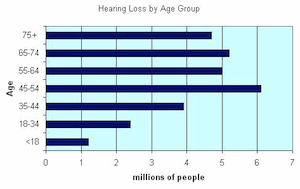
The National Institute on Deafness and Other Communication Diseases estimates that approximately 36 million Americans have a hearing loss of sufficient magnitude to warrant hearing aid use. But, only about 20% of them have purchased–but are not necessarily using–hearing aids.
This disappointing market penetration rate has remained essentially stagnant for the past 30 years or so, perhaps even dropping somewhat since the late 1970s. Everyone can provide their own rationale for this, and many have been presented. In my mind, perhaps the numbers given, and the market penetration, have little to do with the degree of hearing impairment, but instead are related to the degree of “hurt” resulting from the hearing loss.
Keep in mind that “Hearing aids are not fitted based on the degree of hearing loss, but on the degree of hurt. If the hurt is not great enough socially, psychologically, emotionally, or economically, there is no hearing loss.” (Phrase coined by W. Staab over 30 years ago.)
Regardless of the “actual” number of hearing impaired in the population, it is still fair to say that the incidence is fairly high, and most certainly contains some whose “hurt” is not sufficient for them to seek hearing aid solutions, especially when their “hurt” is fairly minor. Reasonable people would believe that those having minor “hurt” should be able to get some amplified experience. Even the hearing aid dispensing organizations that submitted the petition to the FDA stated “. . . .we feel there is a place for PSAPs in the marketplace. . .” 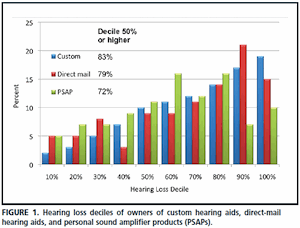
A 2010 study by the Better Hearing Institute (BHI) found that approximately 1.5 million people in the United States now use PSAPs to compensate for hearing loss, and that PSAP users have an average income that’s about $10,000 lower than those who buy hearing aids from qualified professionals.1 Figure 1 shows a comparison of sales for custom hearing aids, Mail order, and PSAP devices.
Interestingly, BHI’s research suggests that PSAPs are not driving people with hearing loss away from appropriate, well-fit hearing aids, as has been suggested by some. BHI notes that the average PSAP customer lived with his/her hearing loss for about eight years before acquiring the device, as opposed to just three years for hearing aid customers. “While there is little doubt that PSAPs are used to compensate for hearing loss, a reasonable estimate is that less than 18% of PSAP users substituted PSAPs for custom hearing aids. In the absence of PSAPs in the marketplace, it’s likely that the majority would have lived with their hearing loss.”
Arguments against direct purchase of PSAPs is that it could place the person’s hearing health in danger. An interesting discussion that is counter to this is presented by Miles Goldsmith, M.D. 2
The real controversy about PSAPs seems to be in defining what that “place” is where they could/should be used, and how that “place” should, or should not, be controlled. Should the person’s “hurt” be defined by some anonymous person, using an arbitrary rule that then dictates treatment procedures under penalty of law, or should the person be allowed to make that determination and take action on their own?
A Little History 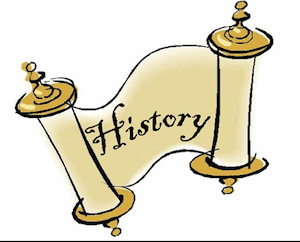
Whatever one wants to call these devices (PSAPs, ALDs, sound amplifiers, etc.), they have been around for many years. Perhaps the first widely-used one is the amplified telephone, but I am certain that some people used other forms of amplification to help them with their hearing losses even before this. Interestingly, the amplified telephone is advertised as making sound louder for people who have hearing loss. And, just as interestingly, it was not considered a hearing aid when the FDA defined the hearing aid as a medical device. To the best of my knowledge, no reason for this has ever been given. I suspect that it just didn’t make sense to label it as a hearing aid, even though it definitely qualified as such by definition and use.
Radios in cars have long had volume controls and graphic equalizers for the listener to obtain additional amplification or make frequency response adjustments in order to “hear” better. I believe that it is a fair bet to say that some of these people had hearing losses even exceeding mild levels. In reality, everyone should be able to identify some kind of amplification device that people with both normal and abnormal hearing levels have had access to, and which were not called hearing aids, but performed much the same action.
Because of inconsistencies such as with the amplified telephone, and then with other devices labeled as Assistive Listening Devices (ALDs), the confusion for purchasers and hearing health care professionals of alternative devices is pervasive. Over-the-counter amplifiers (analog and digital} have been available for decades. Add to this that established manufacturers of electronic devices, such as Bell & Howell, Panasonic, RCA, Sony, etc., have been transferring advanced signal processing, noise-cancellation technology, and miniaturization to a host of consumer devices. This makes sense to me, because how many normal listening consumers seeking to purchase a high-fidelity earbud or earphone would opt for a linear amplifier with no features to promote its use? And, what manufacturer would not want to improve their product?
I was involved in the first of the “game detector” hearing aids, or what is now called a PSAP. They were for the Minnesota Viking head football coach, who was an avid hunter. The problem was that he couldn’t hear well enough to detect the game, but was not ready for hearing aids. We (Audiotone) were asked to build units for the coach to use in the field while 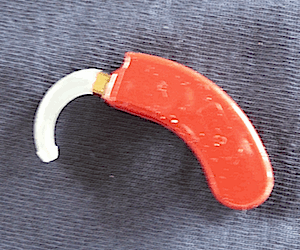 hunting, by a hearing aid dispenser (Harry Rossman) in the Twin Cities. They were to be made red. Why red? This was not a fashion statement as we attempt to show with hearing aids today, but practical so that if he dropped one, it could be seen fairly easily. This was not bad for duck and goose hunting when there was usually quite a bit of snow. But, trying to find these on the ground in the leaves in the fall in
hunting, by a hearing aid dispenser (Harry Rossman) in the Twin Cities. They were to be made red. Why red? This was not a fashion statement as we attempt to show with hearing aids today, but practical so that if he dropped one, it could be seen fairly easily. This was not bad for duck and goose hunting when there was usually quite a bit of snow. But, trying to find these on the ground in the leaves in the fall in 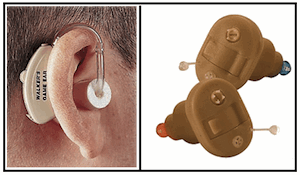 Minnesota was a much more daunting task. Although we were involved in the initial stages of this concept, the Game Detector was never finished because someone at Smith & Wesson, one of Audiotone’s companion Divisions, stated that “The ‘Game Detector, off the top of my head, would seem to be a good idea, but a very limited market for the sporting goods side of our business. Our normal channels of distribution are not tuned in to this type of product.” This device concept has subsequently been manufactured and sold successfully by other companies. This was another example of a product and idea ahead of its time. The year was 1984. Currently, such devices were sold by Cabela’s as the SportEAR Clear Shot (discontinued), and by Bass Pro as Walker’s Game Ear.
Minnesota was a much more daunting task. Although we were involved in the initial stages of this concept, the Game Detector was never finished because someone at Smith & Wesson, one of Audiotone’s companion Divisions, stated that “The ‘Game Detector, off the top of my head, would seem to be a good idea, but a very limited market for the sporting goods side of our business. Our normal channels of distribution are not tuned in to this type of product.” This device concept has subsequently been manufactured and sold successfully by other companies. This was another example of a product and idea ahead of its time. The year was 1984. Currently, such devices were sold by Cabela’s as the SportEAR Clear Shot (discontinued), and by Bass Pro as Walker’s Game Ear.
The Amp Personal Communicator
In a previous article I recalled the story of the Amp Personal Communicator that we designed at Audiotone in 1984. It revealed that the hearing aid industry often does reinvent itself. The device was intended to be used to assist individuals who  had difficulty communicating, but who were not ready for hearing aids. It seemed a good product for individuals who were often in conferences and needed to hear everything that was being said. The copy accompanying the device stated: “You hear well in most situations, but sometimes wish that people would speak more clearly. Maybe in church, during a lecture or if you’re in a crowd. You might wish to hear your family or friends a little better, or want more from a religious service, lecture or conference. Or, you might just want to hear the radio or television more easily.” The product was sold to hearing aid dispensers for sales through their offices, so the distribution channel was not bypassed. Some dispensers started to sell this product under the intended use, but ran into interference and threats of lawsuits (as did Audiotone) from other dispensers and State Hearing Aid Licensing Boards. These actions effectively killed this assistive listening device.
had difficulty communicating, but who were not ready for hearing aids. It seemed a good product for individuals who were often in conferences and needed to hear everything that was being said. The copy accompanying the device stated: “You hear well in most situations, but sometimes wish that people would speak more clearly. Maybe in church, during a lecture or if you’re in a crowd. You might wish to hear your family or friends a little better, or want more from a religious service, lecture or conference. Or, you might just want to hear the radio or television more easily.” The product was sold to hearing aid dispensers for sales through their offices, so the distribution channel was not bypassed. Some dispensers started to sell this product under the intended use, but ran into interference and threats of lawsuits (as did Audiotone) from other dispensers and State Hearing Aid Licensing Boards. These actions effectively killed this assistive listening device.
Radio Shack has been offering a portable amplification device at least since 1991, and I am certain, even prior to then. The unit initially was an amplifier (in a small box) with wired earphones and volume control (not shown). When collecting information for a talk I was to give on ALDs,3 I was told by Ron Slager at HAC, that Radio Shack sold these by the thousands each year to hearing-impaired individuals. It massively exceeded body-style hearing aid sales. It was never called a hearing aid or even an ALD. It was sold as a form of sound amplifier. Radio Shack continues to sell personal amplifiers – but now in alternate designs. (Customer comments on the site are always interesting to read). A few years ago at an American Auditory Society meeting, a well-known audiologist lost his hearing aids. He visited the Radio Shack store and purchased their portable amplifier so he could communicate and participate in the meeting. His hearing loss was severe.
Williams Sound Pocket Talker 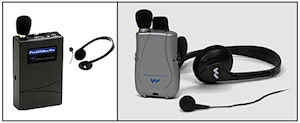
This has been around since 1976. The product has undergone a number of changes over the years, with each new version being improved over the previous unit. It was/is, essentially a body-style hearing aid, except that even in early versions, it had a feature that body aids did not have – a remote mic to improve the SNR (signal-to-noise ratio). Photo at the right shows some of the changes over time.
Next Week’s article will add to this discussion of PSAPs, including more recent contributions.
References and Footnotes
1Kochkin, S. MarkeTrak VIII: Utilization of PSAPs and direct-mail hearing aids by people with hearing impairment. Hearing Review, 2010; 17(6): 12-16)
2Goldsmith, M.M. Another voice…to hear – why it is OK to try retail or mail order hearing aids, June, 2011.
3Staab, W. Assistive listening devices. One-day workshop presentation sponsored by the Speech, Hearing, and Neurosensory Center of Children’s Hospital and Health Center, Can Diego, CA, June 1, 1991.






